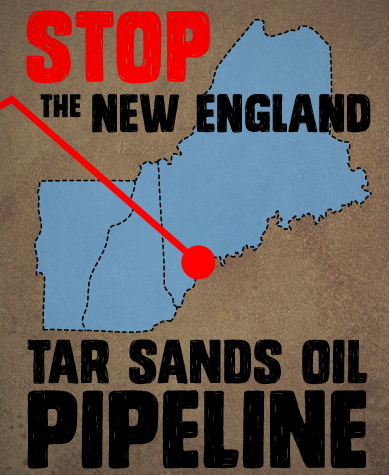
Stop the New England tar sands oil pipeline
Enbridge, the Canadian oil giant responsible for a massive tar sands oil spill into the Kalamazoo River in Michigan not yet two years ago, now wants to pipe tar sands oil—the world’s dirtiest oil—through New England with its Trailbreaker pipeline project.
The Trailbreaker tar sands pipeline project
In August 2011, Enbridge filed a permit application with Canada’s National Energy Board to revive a previous tar sands project, called Trailbreaker. Trailbreaker would transport tar sands oil along an approximately 750-mile route from Ontario and Quebec in Eastern Canada through Vermont, New Hampshire, and terminating in Portland, Maine’s Casco Bay, where the oil would be exported into the international market on super tankers.
The oil industry’s scheme to link the Midwestern pipeline system through eastern Canada and across New England to East Coast ports for export to refineries in the Gulf Coast or overseas was shelved a few years ago and defined as commercially nonviable. The Trailbreaker project would reverse the direction of oil flowing through two major pipelines—Enbridge Line 9 and the Portland/Montreal Pipeline.
Enbridge’s permit application to the Canadian National Energy Board for their Line 9 pipeline reversal is an indication that it’s once again putting the Trailbreaker project back on the table. Although Enbridge has claimed this is a standalone project, the application appears to signal the rebirth of Trailbreaker.
By dividing up the project into two smaller segments, Enbridge could be attempting to shield itself from the type of scrutiny faced by tar sands pipelines like TransCanada’s Keystone XL. Enbridge acknowledged in late 2011 that it was actively pursuing plans to bring tar sands to Ontario, Quebec, and New England.
Tar sands: more toxic than conventional oil
The extraction and processing of tar sands oil is one of the largest industrial operations in the world. Tar sands extraction requires strip mining huge tracts of the pristine Boreal Forest in Alberta, Canada—an area the size of Florida is slated for extraction.
Tar sands oil emits three times more greenhouse gases during production than conventional gasoline and about three barrels of water are polluted and dumped in toxic pools (called tailing ponds) for every barrel of oil produced. These processes use enough energy to make tar sands oil production the fastest-growing contributor to Canada’s carbon pollution and the continent’s biggest carbon bomb.
Tar sands extraction also harms the health and cultural traditions of indigenous communities living downstream from the extraction sites and has been connected to high rates of rare cancers, renal failure, lupus, and hyperthyroidism in the area.
Tar sands pipelines: built to spill
Tar sands pipelines have an abysmal safety record, with a spill rate three times the national average for conventional oil in some parts of the US, putting communities at risk of devastating oil spills and pollution to air and drinking water.
Pipeline safety regulators at the Department of Transportation haven’t yet studied the safety of pipelines that carry tar sands crude or set forth specialized regulations for such pipelines, despite safety concerns unique to corrosive tar-sands oil compared to conventional crude oil. These pipelines must operate at higher temperatures and pressures to move the thick tar sands through a pipe and are subject to severe problems with leak detection and safety issues from the unstable mixture. Tar sands crude is particularly dangerous for older pipelines like the Trailbreaker pipelines, which were constructed during World War II.
Enbridge was responsible for a million gallon tar sands oil spill into the Kalamazoo River in Michigan in June 2010. Two years later, the clean-up costs have surpassed $700 million, residents are still sick from the spill’s toxins, small businesses are still hurting, property values are down, and miles of river remain closed. Now Enbridge wants to pipe tar sands oil through New England with its Trailbreaker project.
Trailbreaker: threatening New England’s natural and cultural landscapes
Trailbreaker would cut through New England’s most important waters, including Sebago Lake, home to a native species of landlocked Atlantic salmon and the major drinking water resource for greater Portland, Maine’s largest metropolitan area. It also terminates at Casco Bay, a large, rich estuary near Portland, Maine that is home to a variety of coastal natural resources and a thriving marine economy.
Trailbreaker would also put at risk Grand River Basin, Lake Ontario, the Saint Lawrence River, Victory State Forest, and Androscoggin River. A spill along Trailbreaker’s corridor could harm rivers, lakes, and bays that are vital resources for millions of people in Canada and the United States.
Take Action
As Canadian regulators begin to consider Enbridge’s plan, it’s crucial that people on both sides of the border speak out. Friends of the Earth is joining with the Natural Resources Defense Council, Sierra Club, and other environmental and public interest groups in New England and Canada to deliver more than 25,000 comments to the Canadian National Energy Board before the deadline this Monday.
By showing that people in both Canada and the U.S. are taking a stand against tar sands oil, you can help us turn up the heat on the National Energy Board to conduct a full accounting of the pipeline’s risks to people’s health and the environment—and continue to build the cross-border coalition we need to stop the tar sands industry once and for all.
More information on the Trailbreaker project:
Natural Resources Defense Council: http://www.nrdc.org/energy/files/keystonetrailbeaker.pdf
The Pembina Institute: http://www.pembina.org/pub/2317
Rabble.ca: http://rabble.ca/news/2013/05/other-enbridge-pipeline-ontarios-line-9-project
Reuters: http://www.reuters.com/article/2011/08/26/us-enbridge-line-idUSTRE77P0Q820110826
Related Posts
Ways to Support Our Work

Read Latest News
Stay informed and inspired. Read our latest press releases to see how we’re making a difference for the planet.

See Our Impact
See the real wins your support made possible. Read about the campaign wins we’ve fought for and won together.

Donate Today
Help power change. It takes support from environmental champions like you to build a more healthy and just world.